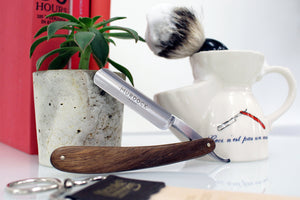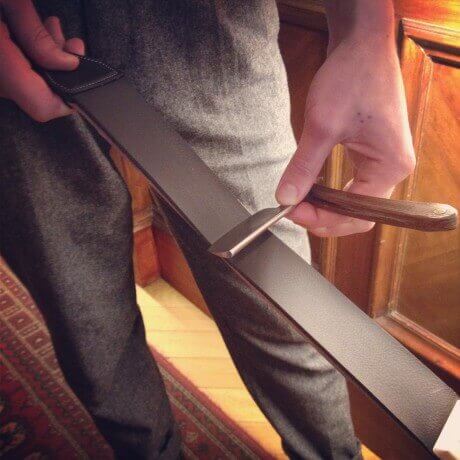
How do I look after my straight razor?
A light stropping of a cut throat razor on a proper leather strop will help to maintain it for many years of satisfying use. Straight razors must be properly cared for in order to ensure their performance longevity. While razors made of stainless steel are less demanding on this front, other types of razors have to be rinsed with clear water and thoroughly dried after each use to avoid rusting and stains on the blade. Remember not to store your razor in a damp and unaired state to minimise the chance of natural wear. When not in use for lengthy periods of time, it is also recommended that a razor be rubbed with a light oil to similarly avoid wear on the pivot mechanism.
Murdock London Cut Throat Razor & Strop
Why use a strop with my cut throat razor?
After several shaves, your razor's cutting edge will become slightly more aligned with the head, which causes bluntness. If you use a strop correctly and treat your blade well, you will only need to hone once every month or even per year. Stropping serves to polish the edge of the blade and to re-align it at the correct angle for sharp, effective shaving.Method of stropping:
(Please read this information very carefully, in order to avoid any damage, either to your fingers or your strop.)How to sharpen a straight razor
Stropping is the best method to sharpen your straight cut throat razor. Read on to find out how to perfectly strop your straight razor.
How to use a strop to sharpen a straight razor
Hang your strop on a hook and pull it towards you, with the leather side up. Now lay the fully opened razor flat.
You should hold the razor at the part between the blade and the handle, just using your fingertips. This enables you to easily turn the razor when stropping. The blade must be laid flat on the strop, so that the cutting edge and the back both make contact. When using the strop, always move the razor towards the back of the blade, NOT towards the cutting edge, or else you will cut the strop to pieces. Pull the blade gently towards you. The blade should stand at approx. 30-40 degrees to the strop. Do not use too much pressure or else the blade will bend, which will alter the sharpening angle. When you reach the end of the belt, roll the blade over the back of the razor and push it back towards the hook. Remember to keep the blade flat on the strop. This sharpens the other side of the blade. Repeat this 4-5 times, and your razor should be ready for work again. It's important to remember that during the whole sharpening-process the back of the blade should never leave the belt. At the end of the belt, do not take the blade off, but simply roll it over.

